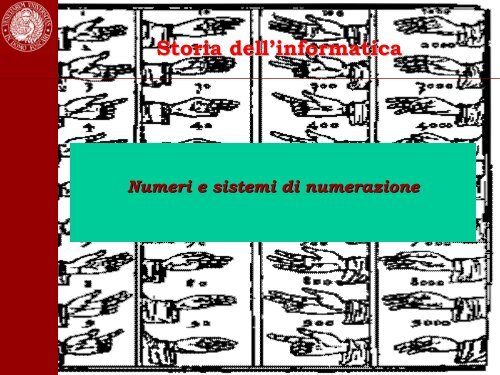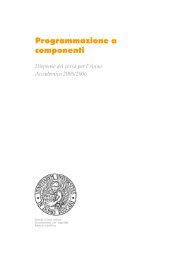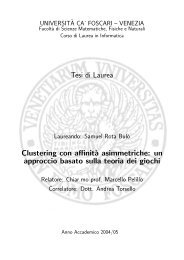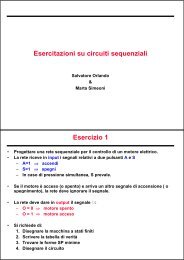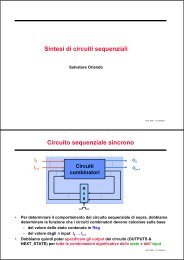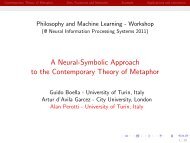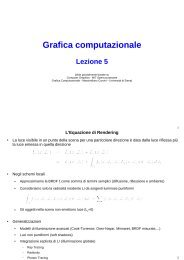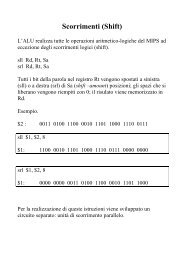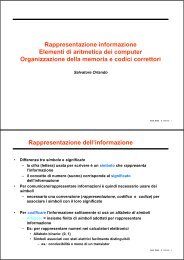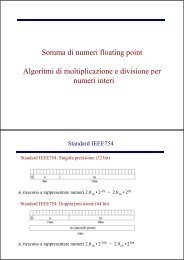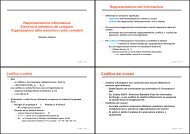Numeri e sistemi di numerazione - Dipartimento di Scienze ...
Numeri e sistemi di numerazione - Dipartimento di Scienze ...
Numeri e sistemi di numerazione - Dipartimento di Scienze ...
Create successful ePaper yourself
Turn your PDF publications into a flip-book with our unique Google optimized e-Paper software.
Storia dell’informatica<br />
<strong>Numeri</strong> e <strong>sistemi</strong> <strong>di</strong> <strong>numerazione</strong>
L’importanza della<br />
rappresentazione<br />
« Many people regard arithmetic as a<br />
trivial thing that children learn and<br />
computers do, but we will see that<br />
arithmetic is a fascinating topic with<br />
many interesting facets. […]<br />
The way we do arithmetic is<br />
intimately related to the way we<br />
represent the numbers we deal with. »<br />
Donald Knuth<br />
The Art of Computer Programming<br />
Vol. 2, pp. 178, 179
Le <strong>di</strong>ta della mano sono il più<br />
semplice <strong>di</strong>spositivo per<br />
contare e furono molto<br />
probabilmente anche il primo<br />
strumento impiegato<br />
dall'uomo preistorico.<br />
L’uso <strong>di</strong> questo “strumento” ha<br />
lasciato una traccia<br />
importante e ben visibile nella<br />
rappresentazione dei numeri.<br />
Infatti, il numero della <strong>di</strong>ta<br />
delle mani ha con<strong>di</strong>zionato la<br />
scelta delle base decimale<br />
attualmente utilizzata nella<br />
rappresentazione dei numeri.<br />
<strong>Numeri</strong> e <strong>di</strong>ta<br />
Luca Pacioli, Summa de arithmetica,<br />
geometria, proportioni et proporzionalità,<br />
Venezia 1494.
<strong>Numeri</strong> e ossa<br />
In Cecoslovacchia (Vestonice), nel<br />
1937, è stato trovato un osso <strong>di</strong><br />
lupo, risalente probabilmente al<br />
30000 a.C., che presenta,<br />
profondamente incise,<br />
cinquantacinque intaccature.<br />
Queste sono <strong>di</strong>sposte in due serie:<br />
venticinque nella prima e trenta<br />
nella seconda; all'interno <strong>di</strong><br />
ciascuna serie le intaccature sono<br />
<strong>di</strong>stribuite in gruppi <strong>di</strong> cinque.
<strong>Numeri</strong> e sassi<br />
L'impiego <strong>di</strong> un insieme <strong>di</strong> gettoni, cioè sassolini, o conchiglie, o<br />
piccoli elementi in creta, ecc. per rappresentare i numeri ha<br />
caratterizzato le civiltà più antiche. Il metodo deriva dall'uso della<br />
<strong>di</strong>ta per contare e in un certo senso ne costituisce un ampliamento.<br />
Ricostruzione <strong>di</strong> gettoni sumeri per la<br />
rappresentazione <strong>di</strong> numeri.
Tra i vari popoli che<br />
utilizzarono ampiamente come<br />
sistema <strong>di</strong> registrazione le<br />
cor<strong>di</strong>celle annodate vanno<br />
sicuramente ricordati gli<br />
Incas, i cui Quipu<br />
permettevano <strong>di</strong><br />
rappresentare dati numerici e<br />
altri tipi <strong>di</strong> informazioni.<br />
Sfortunatamente gran parte<br />
dei quipu è andata persa tra il<br />
1500 e il 1700 con la<br />
colonizzazione europea<br />
<strong>Numeri</strong> e cor<strong>di</strong>celle<br />
Quipu inca (del periodo 1200/1500 d.C)<br />
Museo del calcolo IBM-Europe, Parigi.
L’Egitto e la Mesopotamia
La scrittura egiziana<br />
The Egyptians had a writing system based on hieroglyphs<br />
from around 3000 BC. Hieroglyphs are little pictures<br />
representing words. It is easy to see how they would denote<br />
the word "bird" by a little picture of a bird but clearly without<br />
further development this system of writing cannot represent<br />
many words.<br />
Of course the same symbols might mean something <strong>di</strong>fferent<br />
in a <strong>di</strong>fferent context, so "an eye" might mean "see" while "an<br />
ear" might signify "sound".
Geroglifici
La pietra <strong>di</strong> Rosetta<br />
The Rosetta Stone led to the modern<br />
understan<strong>di</strong>ng of hieroglyphs. Made in<br />
Egypt around 200BC, it is a stone tablet<br />
engraved with writing which celebrates the<br />
crowning of King Ptolemy V. It is a solid<br />
piece of black Basalt and is 1m high by<br />
70cm wide by 30cm deep. Quite heavy.<br />
The interesting thing about the Rosetta<br />
Stone is that the writing is repeated three<br />
times in <strong>di</strong>fferent alphabets:<br />
Hieroglyphic (top of stone)- used by<br />
ancient Egyptians<br />
Demotic (centre of stone)- used by Arabs<br />
inclu<strong>di</strong>ng modern Egyptians<br />
Greek (base of stone)- used by, erm,<br />
Greeks, and other eastern Europeans
La decifrazione dei geroglifici<br />
Thomas Young<br />
(1773-1829)<br />
Jean Francois Champollion<br />
(1790-1832)
<strong>Numeri</strong> e geroglifici<br />
Examples of egyptian<br />
numerals as seen on a<br />
stone carving from<br />
Karnak, dating from<br />
around 1500 BC, and<br />
now <strong>di</strong>splayed in the<br />
Louvre in Paris.
Aritmetica egiziana<br />
Ad<strong>di</strong>ng numeral hieroglyphs is easy. One just adds the<br />
in<strong>di</strong>vidual symbols, but replacing ten copies of a symbol by a<br />
single symbol of the next higher value.<br />
Fractions to the ancient Egyptians were limited to unit<br />
fractions (with the exception of the frequently used 2 / 3 and<br />
less frequently used 3 / 4 ). A unit fraction is of the form 1/n<br />
where n is an integer and these were represented in numeral<br />
hieroglyphs by placing the symbol representing a "mouth“<br />
(pronounced “ro”) which meant “part”, above the number.
Evoluzione dei numerali<br />
geroglifici<br />
We should point out that the hieroglyphs <strong>di</strong>d not remain the<br />
same throughout the two thousand or so years of the ancient<br />
Egyptian civilisation. This civilisation is often broken down<br />
into three <strong>di</strong>stinct periods:<br />
Old Kingdom - around 2700 BC to 2200 BC<br />
Middle Kingdom - around 2100 BC to 1700 BC<br />
New Kingdom - around 1600 BC to 1000 BC<br />
Numeral hieroglyphs were somewhat <strong>di</strong>fferent in these<br />
<strong>di</strong>fferent periods, yet retained a broadly similar style.
Another number system,<br />
which the Egyptians used<br />
after the invention of<br />
writing on papyrus, was<br />
composed of hieratic<br />
numerals. These numerals<br />
allowed numbers to be<br />
written in a far more<br />
compact form yet using the<br />
system required many<br />
more symbols to be<br />
memorised.<br />
Il sistema ieratico
Il sistema ieratico<br />
With this system numbers could be formed of a few symbols.<br />
The number 9999 had just 4 hieratic symbols instead of 36<br />
hieroglyphs. One major <strong>di</strong>fference between the hieratic<br />
numerals and our own number system was the hieratic<br />
numerals <strong>di</strong>d not form a positional system so the particular<br />
numerals could be written in any order.
Matematica e algoritmica<br />
nell’antico Egitto<br />
Papiro <strong>di</strong> Rhind (85 problemi)<br />
Papiro <strong>di</strong> Mosca (25 problemi)
Il papiro <strong>di</strong> Rhind<br />
Largo circa 30 cm e lungo<br />
5,46 m, è stato acquistato nel<br />
1858 in una località balneare<br />
sul Nilo da un antiquario<br />
scozzese, Henry Rhind. Deve<br />
perciò il nome al suo<br />
scopritore: meno<br />
frequentemente è in<strong>di</strong>cato<br />
come Papiro <strong>di</strong> Ahmes, in<br />
onore dello scriba che lo aveva<br />
trascritto attorno al 1660 a.C.<br />
Il contenuto <strong>di</strong> questo papiro<br />
non è scritto nei caratteri<br />
geroglifici ma in scrittura<br />
ieratica (sacra).
Moltiplicazione / 1<br />
Ahmes, in the Rhind papyrus, illustrates the Egyptian<br />
method of multiplication in the following way.<br />
Assume that we want to multiply 41 by 59. Take 59 and add<br />
it to itself, then add the answer to itself and continue:<br />
41 59<br />
_______________________<br />
1 59<br />
2 118<br />
4 236<br />
8 472<br />
16 944<br />
32 1888<br />
_______________________<br />
Since 64 > 41, there is no need to go beyond the 32 entry.
Moltiplicazione / 2<br />
Now go through a number of subtractions:<br />
41 - 32 = 9, 9 - 8 = 1, 1 - 1 = 0 to see that 41 = 32 + 8 + 1.<br />
Next check the numbers in the right hand column<br />
correspon<strong>di</strong>ng to 32, 8, 1 and add them:<br />
41 59<br />
_______________________<br />
1 59 v<br />
2 118<br />
4 236<br />
8 472 v<br />
16 944<br />
32 1888 v<br />
_______________________<br />
2419<br />
Notice that the multiplication is achieved with only<br />
ad<strong>di</strong>tions.
Reversing the factors:<br />
Moltiplicazione / 3<br />
59 41<br />
_____________________<br />
1 41 v<br />
2 82 v<br />
4 164<br />
8 328 v<br />
16 656 v<br />
32 1312 v<br />
_____________________<br />
2419
Precursori dell’aritmetica binaria<br />
Notice that for this method to work we need to know that<br />
every number is the sum of powers of 2. The ancient<br />
Egyptians would not have had a proof of this, nor would<br />
have appreciated that a proof was necessary. They would<br />
just know from practical experience that it could always be<br />
done.<br />
Basically we can think of the method as writing one of the<br />
numbers to base 2. In the examples above we have written<br />
and<br />
41 = 1 · 2 0 + 0 · 2 1 + 0 · 2 2 + 1 · 2 3 + 0 · 2 4 + 1 · 2 5<br />
59 = 1 · 2 0 + 1 · 2 1 + 0 · 2 2 + 1 · 2 3 + 1 · 2 4 + 1 · 2 5
I Babilonesi<br />
The Babylonian civilisation in Mesopotamia replaced the<br />
Sumerian civilisation and the Akka<strong>di</strong>an civilisation.<br />
In terms of their number system the Babylonians inherited<br />
ideas from the Sumerians and from the Akka<strong>di</strong>ans. From the<br />
number systems of these earlier peoples came the base of<br />
60, that is the sexagesimal system. Yet neither the Sumerian<br />
nor the Akka<strong>di</strong>an system was a positional system and this<br />
advance by the Babylonians was undoubtedly their greatest<br />
achievement in terms of developing the number system.<br />
Some would argue that it was their biggest achievement in<br />
mathematics.
Scrittura cuneiforme<br />
Often when told that the Babylonian number system was<br />
base 60 people's first reaction is: what a lot of special<br />
number symbols they must have had to learn!<br />
This comment is based on knowledge of our own decimal<br />
system which is a positional system with nine special<br />
symbols and a zero symbol to denote an empty place.<br />
However, rather than have to learn 10 symbols as we do to<br />
use our decimal numbers, the Babylonians only had to learn<br />
two symbols to produce their base 60 positional system.
Ritrovata nel 1870<br />
La roccia <strong>di</strong> Behistun<br />
Narra la vittoria <strong>di</strong> Dario su Cambise in tre lingue
Il sistema <strong>di</strong> <strong>numerazione</strong><br />
babilonese<br />
Although the Babylonian system was a positional base 60<br />
system, it had some vestiges of a base 10 system within it. This is<br />
because the 59 numbers, which go into one of the places of the<br />
system, were built from a 'unit' symbol and a 'ten' symbol.
Sistema posizionale<br />
Given a positional system one needs a convention<br />
concerning which end of the number represents the units.<br />
For example the decimal 12345 represents<br />
1 · 10 4 + 2 · 10 3 + 3 · 10 2 + 4 · 10 + 5<br />
The Babylonian sexagesimal positional system places<br />
numbers with the same convention, so the right most<br />
position is for the units up to 59, the position one to the left<br />
is for 60 x n where 1
Alcuni problemi <strong>di</strong><br />
rappresentazione<br />
Since two is represented by two characters each representing<br />
one unit, and 61 is represented by the one character for a<br />
unit in the first place and a second identical character for a<br />
unit in the second place then the Babylonian sexagesimal<br />
numbers 1,1 and 2 have essentially the same representation.<br />
However, this was not really a problem since the spacing of<br />
the characters allowed one to tell the <strong>di</strong>fference. In the<br />
symbol for 2 the two characters representing the unit touch<br />
each other and become a single symbol. In the number 1,1<br />
there is a space between them.
E lo zero?<br />
Sembra che in un primo tempo i babilonesi non <strong>di</strong>sponessero <strong>di</strong><br />
un metodo chiaro per in<strong>di</strong>care una posizione vuota cioè non<br />
possedevano nessun simbolo per in<strong>di</strong>care lo zero, anche se<br />
talvolta lasciavano uno spazio vuoto.<br />
Esempio tratto da una<br />
tavoletta cuneiforme (AO<br />
17264, Collezione Louvre <strong>di</strong><br />
Parigi) in cui si calcola il<br />
quadrato <strong>di</strong> 147. In<br />
sessagesimale 147 = 2,27 e<br />
il suo quadrato è 21609 =<br />
6,0,9.
E lo zero?<br />
Tuttavia, ai tempi della conquista <strong>di</strong> Alessandro Magno<br />
si <strong>di</strong>sponeva <strong>di</strong> un segno speciale, consistente in due<br />
piccoli cunei <strong>di</strong>sposti obliquamente<br />
Ciò vuol <strong>di</strong>re che i<br />
babilonesi dell'antichità<br />
non giunsero mai a un<br />
sistema le cui cifre<br />
avessero un valore<br />
posizionale assoluto.<br />
Vantaggio: moltiplicazione “floating point”!<br />
2(60) + 2<br />
2(60)³ + 2(60)²<br />
…
Reciproci<br />
Reciprocals play a significant role in Mesopotamian<br />
mathematics since <strong>di</strong>vision is performed as “multiplication<br />
by the reciprocal”. An important skill for a Mesopotamian<br />
scribe was the ability to find reciprocals, and there are a<br />
number of algorithms for achieving this.<br />
The product of a number and its reciprocal is 1. For any<br />
number n, we let n denote the reciprocal. Then nn = 1. In<br />
Mesopotamia, the notion of the “reciprocal” only appears<br />
after the introduction of the abstract sexagesimal system,<br />
which utilizes a relative place value. No absolute scale of the<br />
numbers is in<strong>di</strong>cated and so, in effect, we treat as a number<br />
and its reciprocal any pair of numbers whose product is a<br />
power of 60, and hence denoted by 1 in the sexagesimal<br />
system.<br />
For example, the reciprocal of 2 is 30 because 2·30 = 1 in<br />
sexagesimal notation. Similarly, the reciprocal of 4 is 15, etc.
Tavole <strong>di</strong> reciproci<br />
There is evidence from early examples of reciprocal tables from<br />
the Ur III period (2100-2000 a.C.) that these pairs were thought<br />
of as factors of 60.
Algoritmi numerici<br />
Physical evidence exists that the Babylonians had a method of<br />
calculating the square root of some numbers as early as 2000<br />
years before the birth of Christ.<br />
The ancient Babylonian method seems to be the same as the<br />
method frequently taught in school text books. The method is<br />
also called Newton’s method, and the <strong>di</strong>vide-and-average<br />
method.
Calcolo della ra<strong>di</strong>ce quadrata<br />
The method is an iterative method which involves the following<br />
steps:<br />
1) Guess a number for the square root<br />
2) Divide the number by the guess<br />
3) Average the original guess and the new guess<br />
4) Make this average value your new “guess” and<br />
5) Go back to step 2…..<br />
In modern notations, to compute √a:
La tavoletta YBC 7289<br />
(1800–1600 a.C.)
Il teorema <strong>di</strong> Pitagora…<br />
mille anni prima <strong>di</strong> Pitagora!<br />
Assuming that the first number is<br />
1; 24,51,10 then converting this to<br />
a decimal gives 1.414212963 while<br />
√2 = 1.414213562.<br />
Calculating 30 x [ 1;24,51,10 ] gives<br />
42;25,35 which is the second<br />
number. The <strong>di</strong>agonal of a square of<br />
side 30 is found by multiplying 30<br />
by the approximation to √2.
La Grecia
Il sistema greco<br />
There were no single Greek national standards in the<br />
first millennium BC. since the various island states<br />
prided themselves on their independence.<br />
This meant that they each had their own currency,<br />
weights and measures etc.<br />
These in turn led to small <strong>di</strong>fferences in the number<br />
system between <strong>di</strong>fferent states since a major function<br />
of a number system in ancient times was to handle<br />
business transactions.
Il sistema acrofonico<br />
(o “attico”)<br />
The first Greek number system we examine is their<br />
acrophonic system which was use in the first millennium BC.<br />
“Acrophonic” means that the symbols for the numerals come<br />
from the first letter of the number name, so the symbol has<br />
come from an abreviation of the word which is used for the<br />
number.<br />
Here are the symbols for the numbers 5, 10, 100, 1000,<br />
10000 (number one was denoted as “I”):
Sistema ad<strong>di</strong>tivo<br />
The system was based on the ad<strong>di</strong>tive principle in a similar<br />
way to Roman numerals.<br />
Here is 1-10 in Greek acrophonic numbers.<br />
Writing bigger numbers:
Il sistema alfabetico<br />
(o “ionico”)<br />
There are 24 letters in the classical Greek alphabet and these<br />
were used together with 3 older letters which have fallen out of<br />
use.
Il sistema alfabetico<br />
(o “ionico”)<br />
Il sistema ionico probabilmente era stato in uso fino dal V secolo a.C.<br />
Una delle ragioni che inducono a far risalire le origini <strong>di</strong> tale notazione a<br />
un'epoca così lontana è l'uso <strong>di</strong> ventisette lettere dell'alfabeto:<br />
nove per i numeri inferiori a 10<br />
nove per i multipli <strong>di</strong> 10 inferiori a 100<br />
nove per i multipli <strong>di</strong> 100 inferiori a 1000.<br />
L'alfabeto greco dell'Età classica contiene solo ventiquattro lettere,<br />
pertanto si dovette far uso <strong>di</strong> un alfabeto più antico che comprendeva le<br />
lettere arcaiche stigma, coppa e sampi.
Roma
I numeri romani<br />
E' da notare che il segno del 500 non è altro che la metà del segno del<br />
1000 e finì col mo<strong>di</strong>ficarsi in una D, come il secondo in una M.<br />
In base alla tabella, per esempio, si ha:<br />
XXX = 10 + 10 + 10 = 30<br />
XII = 10 + 1 + 1 = 12<br />
CXXIII = 100 + 10 + 10 + 1 + 1 + 1 = 123<br />
MMMCCVII = 1000 + 1000 + 1000 + 100 + 100 + 5 + 1 + 1 = 3207.<br />
La notazione romana è perciò un esempio <strong>di</strong> sistema a legge ad<strong>di</strong>tiva.
Sistema ad<strong>di</strong>tivo-sottrattivo<br />
Di regola si usa il numero più grande possibile, così 15 si scrive XV e<br />
non VVV o XIIIII. Da ciò segue che i numeri sono sempre posti da<br />
sinistra a destra in or<strong>di</strong>ne decrescente. Questo potrebbe portare alla<br />
scrittura <strong>di</strong> una lunga successione <strong>di</strong> simboli: per esempio, per<br />
in<strong>di</strong>care 99, si dovrebbe scrivere LXXXXVIIII.<br />
In certi casi, quin<strong>di</strong>, la notazione romana usa anche la notazione<br />
sottrattiva, quando, per esempio, denota il 4 con IV cioè con 5-1. In<br />
generale, si può <strong>di</strong>re che nella notazione romana una cifra che stia<br />
imme<strong>di</strong>atamente a sinistra <strong>di</strong> un'altra che in<strong>di</strong>ca un numero<br />
maggiore va intesa in senso sottrattivo.
E per fare i calcoli?<br />
E' evidente che operare con i numeri romani è abbastanza <strong>di</strong>fficile. A<br />
parte alcuni casi, in cui l'operazione si riduce a una semplice<br />
riscrittura dei simboli.<br />
Esempio:<br />
CXXI + CXII=CCXXXIII<br />
XVI + VII=XXIII<br />
XVII - VI=XI<br />
CXII x II=CCXXIV<br />
Le cose si complicano quando si deve operare con numeri in notazione<br />
sottrattiva:<br />
MCMXCVI + XIV=MCMXCXX=MCMCX=MMX<br />
Esempio:<br />
CMXLV = -100 +1000 -10 +50 +5 = 945<br />
1492 = +1000 +400 +90 +2 = +1000 +(-100+500) +(-10+100) +2 =<br />
MCDXCII
Il nostro sistema <strong>di</strong> <strong>numerazione</strong><br />
Codex Vigilanus:<br />
Codex Vigilanus: viene considerato il più antico testo europeo<br />
contenente le nostre cifre decimali (risale al 976 d.C.). Si nota<br />
che ancora non compare un simbolo per rappresentare lo zero.
Origini indo-arabe<br />
Le origini dell'attuale sistema <strong>di</strong> <strong>numerazione</strong>, il<br />
sistema posizionale decimale, non sono del tutto<br />
chiare. Gli stu<strong>di</strong>osi concordano comunque sul fatto<br />
che furono gli in<strong>di</strong>ani, forse nel VI sec. d.C., ad ideare<br />
il sistema <strong>di</strong> <strong>numerazione</strong> decimale posizionale, che fu<br />
trasmesso in Europa dagli arabi.<br />
Fu probabilmente l'abaco a suggerire agli in<strong>di</strong>ani il<br />
sistema posizionale. Per in<strong>di</strong>care le righe prive <strong>di</strong><br />
sassolini, gli in<strong>di</strong>ani pensarono <strong>di</strong> usare un puntino,<br />
così come noi oggi usiamo lo zero.
Possibile albero genealogico<br />
(K. Menninger, 1957)<br />
Brahmi: arcaico<br />
linguaggio in<strong>di</strong>ano del<br />
X sec. a.C.<br />
In<strong>di</strong>ano antico: si data<br />
intorno al VI sec. d.C.<br />
Sanscrito-Devanagari:<br />
un linguaggio in<strong>di</strong>ano<br />
del VII-XII secc. d.C.<br />
Arabo antico: risale al<br />
VIII-X sec. d.C.
Fibonacci<br />
In Europa, tra i personaggi<br />
che maggiormente<br />
contribuirono ad introdurre<br />
il nuovo sistema <strong>di</strong><br />
<strong>numerazione</strong> decimale<br />
attorno al XIII sec. d.C. va<br />
sicuramente menzionato<br />
Leonardo Pisano (1170-<br />
1250), detto Fibonacci.<br />
Con il suo Liber Abaci (1228)<br />
presentò il sistema<br />
posizionale con gli algoritmi<br />
per le operazioni<br />
evidenziando i notevoli<br />
vantaggi del metodo.
Operazioni con la virgola<br />
La notazione posizionale e la virgola decimale -----------------facilitano<br />
notevolmente le operazioni con i numeri non<br />
interi.<br />
L'introduzione della virgola e delle cifre decimali<br />
permise <strong>di</strong> raffinare il sistema decimale per la<br />
rappresentazione <strong>di</strong> quantità non intere rendendolo<br />
ancora più vantaggioso rispetto agli altri meto<strong>di</strong>.<br />
La moltiplicazione <strong>di</strong> 42,53 e 7,689 non è<br />
essenzialmente più <strong>di</strong>fficile della moltiplicazione dei<br />
numeri interi 4253 e 7689, poiché, a parte la gestione<br />
della virgola, vengono utilizzati i medesimi<br />
proce<strong>di</strong>menti <strong>di</strong> calcolo.<br />
I primi documenti che evidenziano l'impiego della<br />
virgola sono De planis triangulis (1592) <strong>di</strong> Giovanni<br />
Antonio Magini (1555-1617), un astronomo amico <strong>di</strong><br />
Keplero e una tavola dei seni (1593) <strong>di</strong> Cristoforo<br />
Clavio (1537-1612), un gesuita amico <strong>di</strong> Keplero.<br />
| 4253 x |<br />
| 7689 = |<br />
| ----------- |<br />
| 38277 |<br />
| 34024 |<br />
| 25518 |<br />
| 29771 |<br />
| ----------- |<br />
| 32701317 |<br />
------------------<br />
------------------<br />
| 42,53 x |<br />
| 7,689 = |<br />
| ----------- |<br />
| 38277 |<br />
| 34024 |<br />
| 25518 |<br />
| 29771 |<br />
| ----------- |<br />
| 327,01317 |<br />
------------------
Riferimenti<br />
M. R. Williams. A History of Computing Technology. IEEE<br />
Computer Society Press, 1997 (2nd E<strong>di</strong>tion).<br />
C. B. Boyer. A History of Mathematics. John Wiley & Sons, 1968.<br />
(Trad. it.: Storia della matematica, Mondadori, 1980.)<br />
M. Kline. Mathematical Thought from Ancient to Modern Times.<br />
Oxford University Press, 1972. (Trad it.: Storia del pensiero<br />
matematico, Vol. 1, Einau<strong>di</strong>, 1999.)<br />
D. J. Sturk. A Concise History of Mathematics. Dover, 1987 (4th<br />
E<strong>di</strong>tion).<br />
http://www-groups.dcs.st-and.ac.uk/~history/Indexes/HistoryTopics.html<br />
http://www.<strong>di</strong>mi.uniud.it/~cicloinf/mostra/Pagina03.html
Spunti per approfon<strong>di</strong>menti<br />
Storia dello zero<br />
Algoritmi in era babilonese (p. es. D. E. Knuth)<br />
Sistemi <strong>di</strong> <strong>numerazione</strong> orientali<br />
(Cina, In<strong>di</strong>a, Arabia, etc.)


